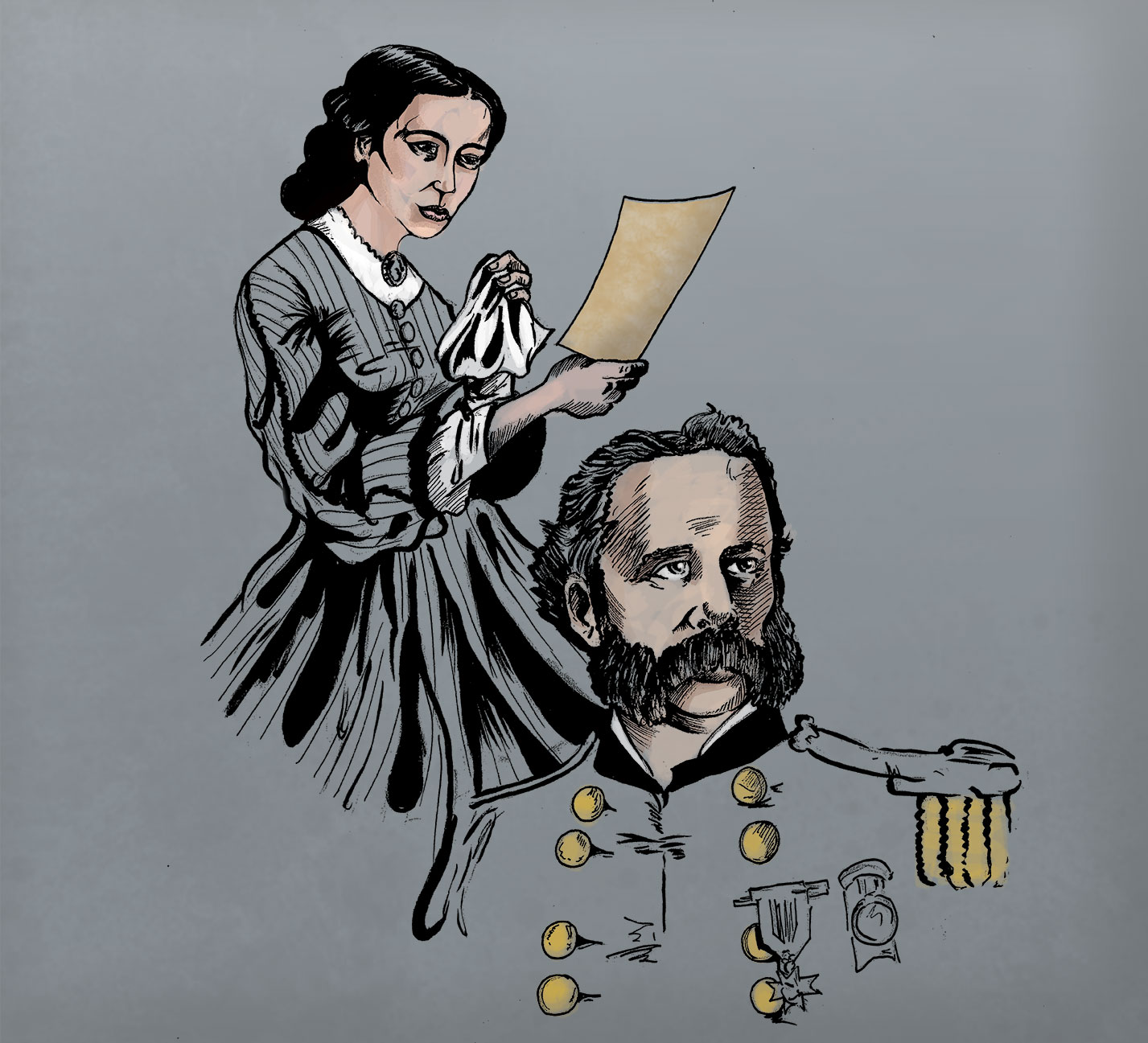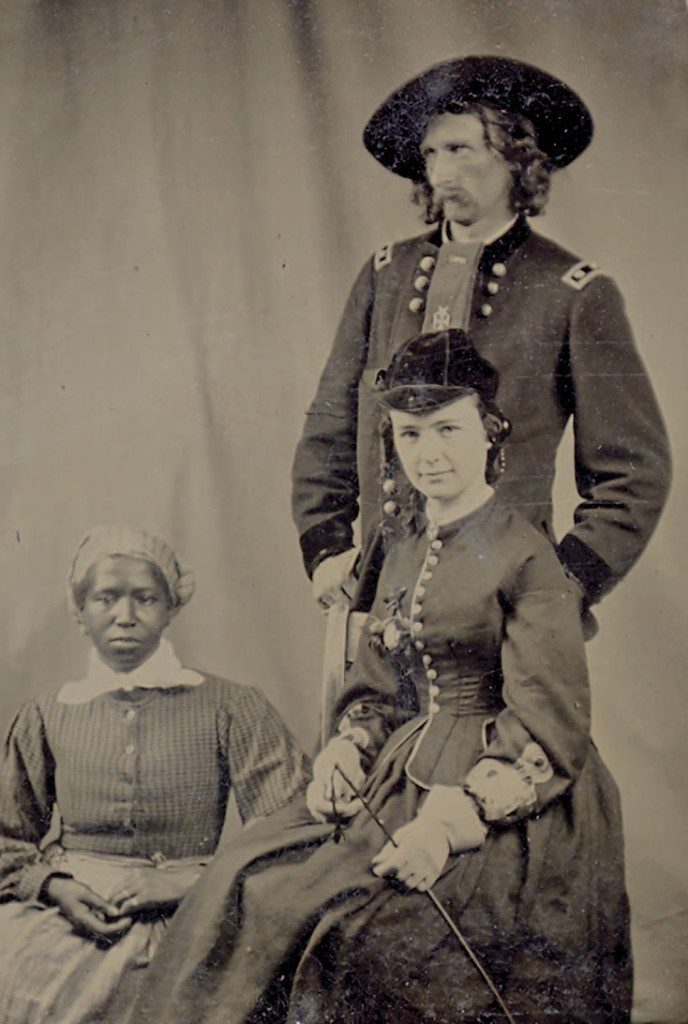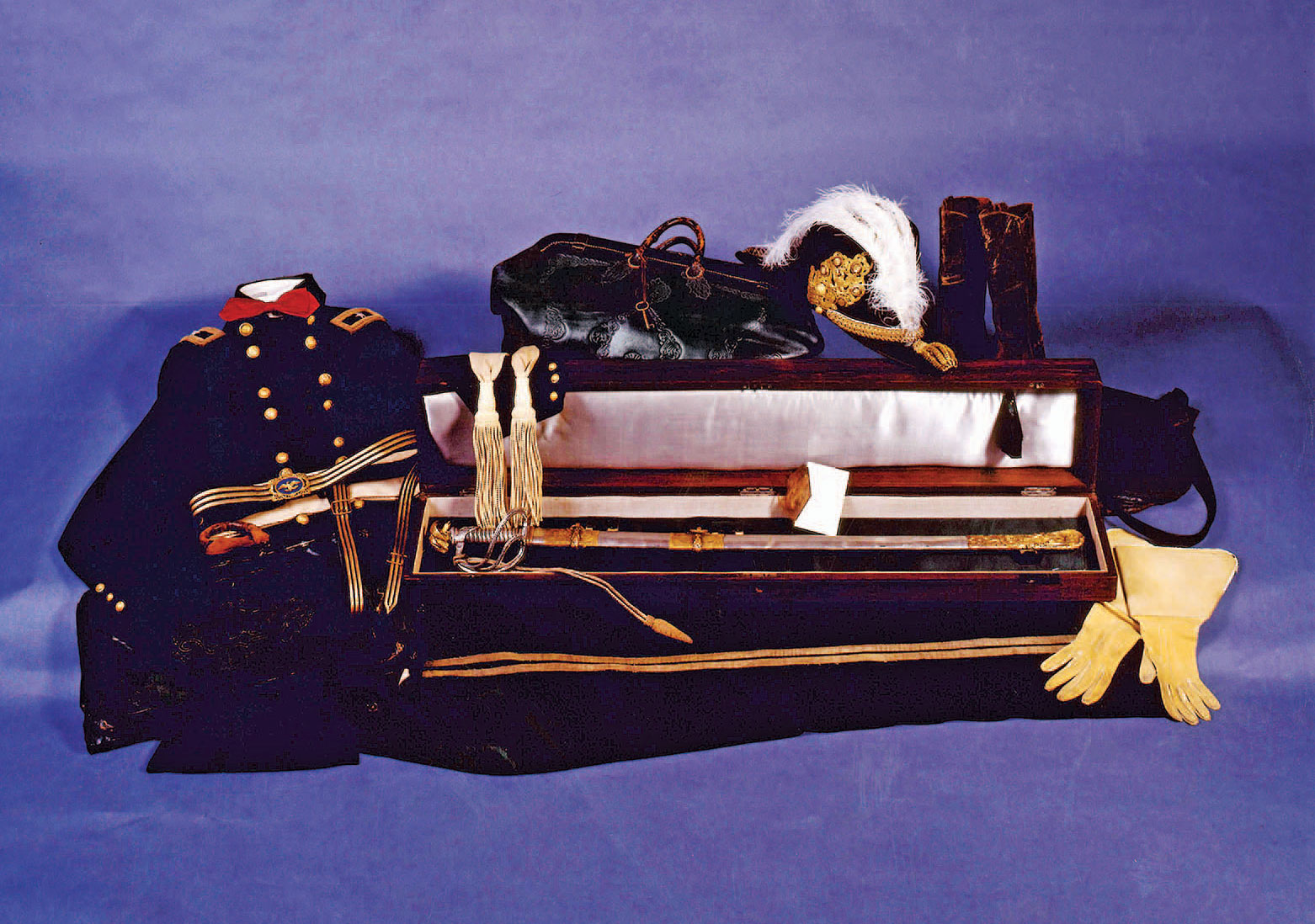
A Union soldier risked his life to return the spoils of war — the intimate correspondence from Gen. Custer’s wife.
How Lt. Wilmon W. Blackmar risked his life to recapture Confederate-looted love letters written by Libbie Custer to her then future husband George sounds like something out of a movie.
The letters, Blackmar relates in his diary, “had fallen into the hands of a Confederate soldier who read them and found them so beautiful in every way that he would not destroy them but sent them home by a wounded man or some messenger, and the Yankee love letters had become quite famous and were in great demand; they were passed from house to house to be read by the young ladies and were often read aloud for the amusement and edification of young people assembled at sewing circles, parties ... at different houses.”
A Confederate prisoner of war tells Blackmar he had seen the letters when he was a guest in a Southern doctor’s home and that he wants to repay Blackmar’s kind treatment of him by taking him there. When Blackmar and the prisoner arrive, Blackmar engages in small talk with the doctor’s two young daughters, eventually working around to the matter of how the girls manage to amuse themselves despite the war. The daughters exclaim that they read Yankee love letters. Blackmar, insisting that Yankees don’t write love letters, eventually cajoles one of them into producing Libbie’s letters as proof.
“She drew out one letter and read it aloud; it was a genuine love letter and a most beautiful one, too. It wound up with, ‘I send you a thousand kisses.’ ‘Did you ever see a kiss in writing?’ said the girl. ‘No, I never did, please let me see how one is put on paper,’ and I rose and stepped in front of her and she handed me the letter. All around the bottom and sides of the sheet were a lot of little rings or ‘O’s’ — the kisses. ‘Well,’ said I, ‘you have defeated me, surely this is a love letter and it bears the marks of being genuine. Did the envelopes bear the postmarks of a Northern town?’ And I gently and quietly reached down and took the packages from her lap to examine them. When I had them, I said, ‘I must acknowledge that I am wrong and you are right. These are Yankee love letters and they belong to my friend and beloved General and I will take them to him,’ and I thrust them into my blouse over my belt.”
When Blackmar reveals the true purpose of his visit, “The frightened girl gave a most unearthly scream and instantly every door on the sides and end of the room except the one from the piazza, from which I entered, was thrown open and one or more Confederate soldiers appeared in each doorway. Like a flash photograph, I took in the situation at a glance. One of them had a terrible wound in or near his eye, it appeared as if his eye was out of its socket and hanging down towards his cheek, a ghastly sight; another carried his arm in a sling. ... As I glanced around I thought they were all wounded. ... [T]hey were Confederate soldiers hidden in this Doctor’s house and being treated by him professionally.”
Seeing he is in a tight spot, Blackmar addresses the men. “ ‘Gentlemen, I have done this lady no harm, nor do I propose to do so. I have strangely enough found some property belonging to my beloved General, valuable only to him, a bundle of love letters written to him by the woman who is now his wife, and I intend to take these letters to him.’ ” Backing toward the piazza door, he and his prisoner-guide exit hurriedly. “Instantly we were in our saddles and away.”

After an all-night ride, they enter their camp. “[D]rawing up before the sentinel on duty in front of General Custer’s headquarters, I asked if the General was stirring yet, and the sentinel answered ‘Yes, he just looked out.’ As I spoke, the door of the little cottage which the general appropriated for his headquarters was thrown open and General Custer appeared in the doorway. I saluted him and taking the bundle of letters from the breast of my blouse and handing them to him, I asked, ‘Do these belong to you General?’ He took them, making no answer, but laughing and dancing ’round the room, I saw him toss the bundle of letters towards the other side of the room, and heard him call out, ‘Oh! Libbie see what he has brought me.’ ... I afterwards heard that Mrs. Custer had come down from Washington and joined her husband that very evening, after I had left camp in quest of the letters, and it was into her lap he tossed the letters I handed him.”
Blackmar’s diary can be found on exhibit through the end of September 2017 at Cisco’s Gallery in Coeur d’Alene, Idaho, with the fascinating General Custer Trevilian Collection, which consists in the main of the entire contents of Custer’s personal baggage wagon that was captured by the Confederacy at the Battle of Trevilian Station.
“They took all of his personal possessions, leaving him without even a toothbrush,” says Civil War historian Eric J. Wittenberg, author of Glory Enough for All: Sheridan’s Second Raid and the Battle of Trevilian Station. “They even captured Eliza, his cook. But she made such a royal pain in the ass of herself that the Confederate forces let her escape that night because they didn’t want to deal with her.”
Custer would see Eliza and the love letters again, but not the rest of his belongings. Yet the General had bigger concerns on his mind. The largest, bloodiest all-cavalry engagement of the Civil War, “Trevilians” would come to be known as Custer’s First Last Stand.
“The parallels are striking,” Wittenberg says. “As he did at Little Bighorn, Custer made a reckless charge into the face of enemy forces without looking to see what was in front of him and got himself completely surrounded. In 1876, his luck ran out; in 1864, it didn’t. More important, several of the officers who died at Little Bighorn were with him at Trevilians that day, including George Yates of the 7th Michigan Cavalry.”
In the fighting in central Virginia at Trevilian Station June 11 – 12, 1864, “Custer’s brigade took heavy, heavy losses, such that it was combat-ineffective for several months after,” Wittenberg says. Initially it had looked like it would be a win for the Union. “The first day Union forces captured a Confederate wagon train that ultimately they weren’t able to hold. Custer had seen the wagon train and, without taking precautions, he ordered the 5th Michigan Cavalry to take it, not realizing that a regiment of Confederate cavalry was around.” Blunted first by a force of Georgia cavalrymen, Custer would soon be attacked by his old friend from West Point, Gen. Thomas Rosser and his Laurel Brigade.
“As the fighting swirled around him, Custer was seemingly everywhere,” Wittenberg writes in his article “Custer’s First Last Stand” on the Civil War Trust website. “He rescued a badly wounded trooper of the 5th Michigan while under heavy fire, and was badly bruised by two spent balls that did not break the skin. The officer responsible for the wagons asked Custer if he could take his prize to the rear. The distracted ‘Boy General’ said, ‘Yes, by all means.’ Relieved, the officer left to lead the wagons to safety. As he rode off, one member of the 7th Michigan heard Custer inquire, ‘Where in hell is the rear?’ ”
That’s how bad the melee was.
“It was total confusion,” says David Ingall, co-author of Michigan Civil War Landmarks and former assistant director of the Monroe County Historical Museum in Monroe, Michigan, where Custer (and Ingall) grew up. “Custer had nine lives in the Civil War. It was a miracle he survived the Battle of Trevilian Station.”
Custer got out of the jam with the help of Union cavalry reinforcements, who, as Wittenberg characterizes it, cut their way through to him and opened a passageway. For Ingall, it was also a matter of the 24-year-old Custer’s tenacity.
In the aftermath, Custer’s correspondence and personal love letters were sent to Richmond, Virginia, where some soon appeared in the Richmond newspaper. The rest of the prized possessions captured by Rosser’s command were claimed and preserved by Lt. Frank Blair, a Confederate Texas cavalryman, who eventually got the items to Texas for safekeeping. He is said to have turned down a request by Gen. Rosser — who had the tables turned on him when Custer captured his wagon at the Battle of Tom’s Brook in October 1864 — that the items be returned to Custer. Blair eventually sold the collection in 1897 to W.N. Allen of San Antonio, Texas, a Confederate veteran and collector. After passing through several private collections, the items were ultimately acquired in 2000 by Cisco’s Gallery and spent the next decade on exhibit at the Little Bighorn Battlefield National Monument in Crow Agency, Montana; the Monroe County Historical Museum; and the National Civil War Museum in Harrisburg, Pennsylvania.

For Ingall, who was the assistant director at the museum in Monroe when the collection was exhibited, the most evocative item among Custer’s possessions might be his Tiffany & Co. presentation cavalry saber: “The sword is exquisite; it was given to him by his staff officers in the Michigan Cavalry Brigade. It’s just incredible — very beautiful.” The other thing Ingall especially loves is Custer’s brigadier general’s dress frock coat. After poring over letters, books, and photographs of Custer wearing the coat before and after his wedding day (no known photo of Custer exists on that particular occasion), Ingall believes it is the coat Custer was probably married in. Pointing out the precise way the buttons are spaced on a brigadier general’s dress frock, Ingall admits that Custer is something of an obsession. Years later, he’s still moved by the memory of seeing the Boy General’s artifacts in person.
“When we had the Trevilian Collection on exhibit, I would go up at night and just look at it,” Ingall says. “Seeing all of it assembled there in one place, I thought about how these items were captured in 1864 and Custer would never see them again — and how here they were back in his hometown. We were so thankful to be able to have that very valuable collection in Monroe. What makes it so important not just to Monroe but to the entire country and American history is that it’s all intact. Usually these things go to the four winds, but the Trevilian Station items stayed together. These are the largely intact belongings of a famous person in American history captured in the largest all-cavalry battle of the Civil War. It’s truly a prominent collection in Civil War history.”
Along with the sword and the wedding outfit Custer wore when he married Libbie in February 1864 — just months before the Battle of Trevilian Station — the collection also includes Custer’s writing desk. Libbie’s love letters — one of which asks Custer to save his hair from the barber so that “when I’m old I’ll have a wig made” — ended up elsewhere after being returned. But there is in the collection the letter Libbie wrote to Blackmar thanking him for recapturing and returning them.
In a Victorian-looking font, the stationery of her thank-you is imprinted “En Route Wagner Vestibuled Train.” In large flowing cursive with expansively crossed T’s, the letter — dated December 6 and signed Elizabeth B. Custer — begins, “My dear General ...
“I was so touched by your letter with its beautiful allusions to my husband and its tender references to our happy life in the past that I want to thank you for myself and for the one who cannot now tell you of his gratitude for your loyalty. How happy he would be to know that justice — tho’ tardy — had rewarded you for your valorous deed. ...”
Though Custer is said to have chided Libbie after her effusive letters were captured, he was not above responding to her charming written requests, as one extremely personal item in the Trevilian Collection attests: In an unposted Civil War-era envelope there remains to this day a single lock of Custer’s famous blond hair.
How the ladies in the Southern sewing circles would have swooned.
The General Custer Trevilian Collection is on display through the end of September 2017 at the Cisco’s Gallery in Coeur d’Alene, Idaho. A special presentation open to the public (RSVP required) will be held September 23 and 24 at the Coeur d’Alene Resort. For more information, contact Cisco’s Gallery at 208.769.7575.
From the May/June 2016 issue.














